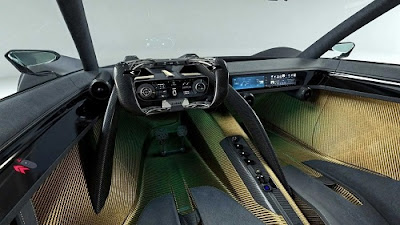ONE-OFF We are interested to know more while seeing this fairly beautiful car shaped on the Pinterest pages. Besides having a beautiful shape, it turns out that its unusual name factor also sparked the desire to get to know the figure of this car more closely. After surfing and searching in the internet, finally we're knew that the car's name comes from the name of the person who designed it, Frederick Zeder Jr.
 |
| 1953 Zeder Storm Z-250 concept car by Frederick Zeder Jr. and bodywork by Bertone. (Picture from: OldConceptCars) |
 Like Carol Shelby, the young Zeder had matured in the automotive racing world before serious getting involved into the car design, he was also obsessed with creating a sports car that could become a serious competitor to Jaguar and Ferrari cars both on the racing track and streets.
Like Carol Shelby, the young Zeder had matured in the automotive racing world before serious getting involved into the car design, he was also obsessed with creating a sports car that could become a serious competitor to Jaguar and Ferrari cars both on the racing track and streets.What's the idea? As quoted from DriveTribe, his dream car is a dual purpose sports car only with just a simple switch on the car's body can be converted from racing use and street use. So then was born the Zeder Storm Z-250.
 |
| 1953 Zeder Storm Z-250 concept car while on display at the Peterson Automotive Museum in Los Angeles. (Picture from: ReddIt) |
 It turns out that in the making of this beautiful car also involved the famous Italian coachbuilder Bertone, it's not surprising if the car was known as one of numerous Bertone's designs in the 1950s. Besides that, there are also many people who know it as the Dodge Storm Z-250, due to the concept car uses the Dodge's mechanical elements.
It turns out that in the making of this beautiful car also involved the famous Italian coachbuilder Bertone, it's not surprising if the car was known as one of numerous Bertone's designs in the 1950s. Besides that, there are also many people who know it as the Dodge Storm Z-250, due to the concept car uses the Dodge's mechanical elements. |
| 1953 Zeder Storm Z-250 concept car interior featured with a brown colored steering wheel, the same nuanced dashboard that consisted by several sporty instruments panels and two genuine-leather covered bucket seats. (Picture from: MyCarQuest) |
In fact the car was designed independently by Fred Zeder Jr. along with the great engineers at that time such as Carl Breer, Gene Cassaroll, Hank Kean and John Butterfield to be proposed as a Chrysler's grand coupé. After completing the design then Zeder Jr. commissioned the Italian master craftsmen Bertone to build the car bodywork. And the result is a beautiful American sports car with a touch of an Italian flare.
 |
| 1953 Zeder Storm Z-250 concept car uses a Dodge HEMI V8 engine which is capable of producing 260bhp of power and making acceleration performance from 0 to 60 in just 7.5 seconds. (Picture from: Roeteveechie.org) |
The model reflects the Bertone style of the period, with particular attention to the lines and design of the American car, especially with regards to the long streamlined front bonnet, smooth wings and imposing horizontal radiator grille.
The car built on a rigid tube frame chassis it was intended to be a dual-purpose sports and racing car. When raced the comfortable touring body currently fitted could be removed by unscrewing four bolts and replaced with an ultra light 150 pound fiberglass body.
As
the driving force, the Storm Z-250 uses a Dodge HEMI V8 engine which is
capable of producing 260bhp of power and making acceleration
performance from 0 to 60 in just 7.5 seconds. Meanwhile the car's other
components such as brakes, suspension and steering rack are also taken
from some other Chrysler vehicles.
 |
| If the Zeder Storm Z-250 would have gone into production it would have competed with the Ford Thunderbird, Chevrolet Corvette and the Kaiser Darrin. (Picture from: OldConceptCars) |
Zeder Jr. was delighted by the enthusiastic reception of the Italian audience for his car, then he brought it back to the US to offer it to Chrysler in the hopes that the American manufacturer would be interested in producing the car.
 However, after arriving in the US, it turned out that Chrysler refused because the Storm Z-250 was considered too expensive and not profitable for the company. Though Zeder Jr. could have offered his car to others, but he wasn't do that due to the Chevrolet Corvette and Ford Thunderbird had made debuts. So he gave up on his dream of producing the dual purpose racer and put the only-one built concept car into his garage.😢
However, after arriving in the US, it turned out that Chrysler refused because the Storm Z-250 was considered too expensive and not profitable for the company. Though Zeder Jr. could have offered his car to others, but he wasn't do that due to the Chevrolet Corvette and Ford Thunderbird had made debuts. So he gave up on his dream of producing the dual purpose racer and put the only-one built concept car into his garage.😢After being rejected by Chrysler, this car was seen several times on display at various institutions and events. In fact, with such exquisite style and potential, it's sad that the car was never produced. In our opinion, this car actually deserves to be a serious competitor for the Corvette, Thunderbird, Jaguar, even Ferrari at the time.😒 *** [EKA [02122020] | FROM VARIOUS SOURCES | JALOPNIK | OLDCONCEPTCARS | DRIVETRIBE ]
Note: This blog can be accessed via your smart phone.




































